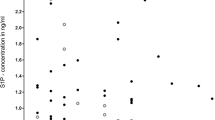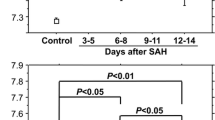Summary
Several naturally occurring compounds have been identified in human cerebrospinal fluid (CSF) after subarachnoid haemorrhage (SAH) as possible vasoactive agents involved in the biochemical mechanism of vasospasm. The authors have measured, in 30 patients admitted for SAH, CSF concentrations of two arachidonic acid metabolites, Prostacyclin and Prostaglandin D2, as representative of vasodilator and vasoconstrictor compounds. CSF samples were made available by lumbar punctures and intraoperative cisternal punctures. Nine patients presented with symptomatic vasospasm: lumbar CSF Prostaglandin D2 levels are significantly higher than in patients without vasospasm. The Cisternal Prostaglandin D2 level is significantly higher than the lumbar CSF concentration; CSF Prostacyclin levels do not significantly differ in the two groups of patients. These data suggest the presence of an imbalanced biochemical situation responsible for promoting vasospasm. The evaluation of cisternal levels of arachidonate metabolites support the hypothesis of the clotting phenomenon around the ruptured aneurysm wall as an important predictive pattern of vasospasm onset after SAH, as shown in computed tomography.
Similar content being viewed by others
References
Adams HP Jr, Kassell NF, Torner JC (1985) Usefulness of computed tomography in predicting outcome after subarachnoid hemorrhage. A preliminary report of the Cooperative Aneurysm Study. Neurology 35: 1263–1267
Asano T, Tanishima T, Sasaki T, Sano K, Possible participation of free radical reactions initiated by clot lysis in the pathogenesis of vasospasm after subarachnoid hemorrhage. In: Wilkins RH (ed) Cerebral arterial spasm. Williams & Wilkins, Baltimore, pp 190–201
Boullin, DJ, Du Boulay GH, Rogers AT (1978) Aetiology of cerebral arterial spasm following subarachnoid hemorrhage: evidence against a major involvement of 5-hidroxytryptamine in the production of acute spasm. Br J Clin Pharmacol 6: 203–215
Boullin DJ, Brandt L, Ljunggren B, Tagari P (1981) Vasoconstrictor activity in cerebrospinal fluid from patients subjected to early surgery for ruptured intracranial aneurysm. J Neurosurg 55: 237–245
Brandt L, Ljunggren B, Anderson KE, Hindfelt B (1981) Individual variations in response of human cerebral arterioles to vasoactive substances, human plasma, and CSF from patients with aneurysmal SAH. J Neurosurg 55: 431–437
Fisher CM, Roberson GH, Ojemann RG (1977) Cerebral vasospasm with ruptured saccular aneurysm—the clinical manifestations. Neurosurgery 1: 245–248
Fisher CM, Kistler JP, Davis JM (1980) Relation of cerebral vasospasm to subarachnoid hemorrhage visualized by computerized tomographic scanning. Neurosurgery 6: 1–9
Gaetani P, Rodriguez y Baena R, Silvani V, Rainoldi F, Paoletti P (1986) Prostacyclin and vasospasm in subarachnoid hemorrhage from ruptured intracranial aneurysm. A clinical preliminary study. Acta Neurol Scand 73: 33–38
Hunt W, Hess R (1968) Surgical risk as related to time of intervention in the repair of intracranial aneurysms. J Neurosurg 28: 14–20
Kassell NF, Boarini DJ (1982) Cerebral ischemia in the aneurysm patient. Clin Neurosurg 29: 657–665
Kassell NF, Sasaki T, Colohan ARI, Nazar G (1985) Cerebral vasospasm following aneurysmal subarachnoid hemorrhage. Stroke 16: 562–572
Kaye AH, Tagari PC, Teddy PJ, Adams CB, Blaso WP, Boullin DJ (1984) CSF smooth-muscle constrictor activity associated with cerebral vasospasm and mortality in SAH patients. J Neurosurg 60: 927–934
Kistler JP, Crowell RM, Davis KR, Heros R, Ojemann RG, Fisher CM (1983) The relation of cerebral vasospasm to the extent and location of subarachnoid blood visualized by CT scan: a prospective study. Neurology 33: 424–436
La Torre E, Patrono C, Fortuna A (1974) Role of PGF2-alpha in human cerebral vasospasm. J Neurosurg 41: 293–299
Mizukami M, Kawase T, Usami T, Tazawa T (1982) Prevention of vasospasm by early operation with removal of subarachnoid blood. Neurosurgery 10: 301–307
Nizuma H, Kwak R, Otabe K, Suzuki J (1979) Angiography study of cerebral vasospasm following the rupture of intracranial aneurysms. II. Relation between the site of aneurysm and the occurrence of the vasospasm. Surg Neurol 11: 263–267
Ohta H, Ito Z, Yasui N, Suzuki A (1982) Extensive evacuation of subarachnoid clot for prevention of vasospasm ... effective or not? Acta Neurochir (Wien) 63: 111–116
Ohta T, Kajikawa H, Yoshikawa Y, Shimizu K, Funatsu N, Yamamoto M, Toda N (1980) Cerebral vasospasm and hemoglobins: clinical and experimental studies. In: Wilkins RH (ed) Cerebral arterial spasm. Williams & Wilkins, Baltimore, pp 166–172
Okamoto S, Handa H, Toda N (1984) Role of intrinsic arachidonate metabolites in the vascular action of erythrocyte break-down products. Stroke 15: 60–64
Osaka K (1977) Prolonged vasospasm produced by the break-down products of erythrocytes. J Neurosurg 47: 403–411
Paul SK, Whalley ET, Forster C, Lye R, Dutton J (1982) Prostacyclin and cerebral vessel relaxation. J Neurosurg 57: 334–340
Quintana L, Kouda R, Ishibashi Y, Yoshimoto T, Suzuki J (1982) The effect of prostacyclin on cerebral vasospasm. An experimental study. Acta Neurochir (Wien) 62: 187–193
Rodriguez y Baena R, Gaetani P, Folco G, Branzoli U, Paoletti P (1985) Cisternal and lumbar CSF concentration of arachidonate metabolites in vasospasm following subarachnoid hemorrhage from ruptured aneurysm. Surg Neurol 25: 428–432
Saito I, Ueda Y, Sano K (1977) Significance of vasospasm in the treatment of ruptured intracranial aneurysms. J Neurosurg 47: 292, 429
Saito I, Shigeno T, Aritake K, Tanishima T, Sano K (1979) Vasospasm assessed by angiography and computerized tomography. J Neurosurg 51: 466–475
Sano K, Asano T, Tanishima T, Sasaki T (1980) Lipid peroxidation as a cause of cerebral vasospasm. Neurol Res 2: 243–272
Sano K, Saito I (1980) Early operation and washout of blood clots for prevention of cerebral vasospasm. In: Wilkins RH (ed) Cerebral arterial spasm. Williams & Wilkins, Baltimore, pp 510–513
Sasaki T, Murota SI, Wakai S, Asano T, Sano K (1981) Evaluation of prostaglandin biosynthetic activity in canine basilar artery following subarachnoid injection of blood. J Neurosurg 55: 771–778
Sasaki T, Asano T, Takakura K, Sano K, Kassell NF (1984) Nature of the vasoactive substance in CSF from patients with subarachnoid hemorrhage. J Neurosurg 60: 1186–1191
Sundt TM Jr, Whisnant JP (1978) Subarachnoid hemorrhage from intracranial aneurysms: surgical management and natural history of disease. N Eng J Med 299: 116–122
Suzuki J, Komatsu S, Sato T, Sakurai Y (1980) Correlation between CT findings and subsequent development of cerebral infarction due to vasospasm in subarachnoid hemorrhage. Acta Neurochir (Wien) 55: 63–70
Suzuki N, Nakamura T, Imabayashi S, Ishikawa Y, Sasaki T, Asano T (1983) Identification of 5-hydroxy-eicosatetraenoic acid (5-HETE) in cerebrospinal fluid after subarachnoid hemorrhage. J Neurochem 41: 1186–1189
Suzuki S, Iwabuchi T, Tanaka T, Kanayama S, Ottomo M, Hatanaka M, Aihara H (1985) Prevention of cerebral vasospasm with OKY-046 an Imidazole derivative and a thromboxane synthetase inhibitor. A preliminary co-operative clinical study. Acta Neurochir (Wien) 77: 133–141
Tanishima T (1980) Cerebral vasospasm: contractile activity of hemoglobin in isolated canine basilar arteries. J Neurosurg 53: 787–793
Von Holst H, Granstrom E, Hammarstrom S, Samuelsson B, Steiner L (1982) Effect of Leucotrienes C4, D4, Prostacyclin and Thromboxane A2 on isolated human cerebral arteries. Acta Neurochir (Wien) 62: 177–185.
Walker V, Pickard JD, Smythe P, Eastwood S, Perry S (1983) Effects of subarachnoid hemorrhage on intracranial prostaglandins. J Neurol Neurosurg Psych 46: 119–125
Weir BKA (1980) The incidence and onset of vasospasm after subarachnoid hemorrhage from ruptured aneurysm. In: Wilkins RH (ed) Cerebral arterial spasm. Williams & Wilkins, Baltimore, pp 385–393
White RP (1983) Vasospasm I: Experimental findings. In: Fox JL (ed) Intracranial aneurysms. Springer, Heidelberg New York Tokyo, pp 218–249
White RP, Robertson JT (1985) Role of Plasmin, Thrombin and Antithrombin III as etiological factors in delayed cerebral vasospasm. Neurosurgery 16: 27–35
Author information
Authors and Affiliations
Additional information
This research was supported by a grant of the Italian Department of Instruction, Rome, Italy, 1984 and by a grant of Regione Lombardia.
Rights and permissions
About this article
Cite this article
Rodriguez y Baena, R., Gaetani, P., Silvani, V. et al. Cisternal and lumbar CSF levels of arachidonate metabolites after subarachnoid haemorrhage: An assessment of the biochemical hypothesis of vasospasm. Acta neurochir 84, 129–135 (1987). https://doi.org/10.1007/BF01418838
Issue Date:
DOI: https://doi.org/10.1007/BF01418838




